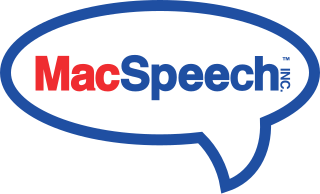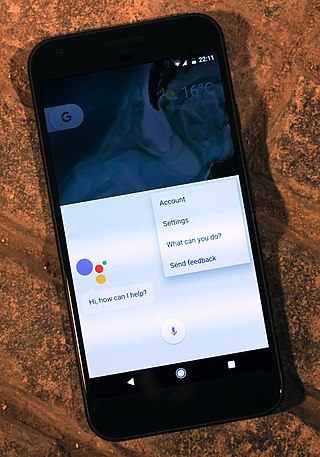IBM ViaVoice was a range of language-specific continuous speech recognition software products offered by IBM. The current version is designed primarily for use in embedded devices. The latest stable version of IBM Via Voice was 9.0 and was able to transfer text directly into Word.

MacSpeech, Inc. was a New Hampshire-based technology company that produced software-based speech recognition and voice dictation solutions for the Apple ecosystem. The company's products included iListen, MacSpeech Dictate, MacSpeech Dictate Medical, MacSpeech Dictate Legal, MacSpeech Dictate International, and MacSpeech Scribe. On February 12, 2010, Nuance Communications, Inc. acquired MacSpeech.

Dragon NaturallySpeaking is a speech recognition software package developed by Dragon Systems of Newton, Massachusetts, which was acquired in turn by Lernout & Hauspie Speech Products, Nuance Communications, and Microsoft. It runs on Windows personal computers. Version 15, which supports 32-bit and 64-bit editions of Windows 7, 8 and 10, was released in August 2016.
A voice-user interface (VUI) enables spoken human interaction with computers, using speech recognition to understand spoken commands and answer questions, and typically text to speech to play a reply. A voice command device is a device controlled with a voice user interface.
The Speech Application Programming Interface or SAPI is an API developed by Microsoft to allow the use of speech recognition and speech synthesis within Windows applications. To date, a number of versions of the API have been released, which have shipped either as part of a Speech SDK or as part of the Windows OS itself. Applications that use SAPI include Microsoft Office, Microsoft Agent and Microsoft Speech Server.

A dictation machine is a sound recording device most commonly used to record speech for playback or to be typed into print. It includes digital voice recorders and tape recorder.
As of the early 2000s, several speech recognition (SR) software packages exist for Linux. Some of them are free and open-source software and others are proprietary software. Speech recognition usually refers to software that attempts to distinguish thousands of words in a human language. Voice control may refer to software used for communicating operational commands to a computer.

Windows Speech Recognition (WSR) is speech recognition developed by Microsoft for Windows Vista that enables voice commands to control the desktop user interface, dictate text in electronic documents and email, navigate websites, perform keyboard shortcuts, and operate the mouse cursor. It supports custom macros to perform additional or supplementary tasks.
Natural-language user interface is a type of computer human interface where linguistic phenomena such as verbs, phrases and clauses act as UI controls for creating, selecting and modifying data in software applications.

A virtual assistant (VA) is a software agent that can perform a range of tasks or services for a user based on user input such as commands or questions, including verbal ones. Such technologies often incorporate chatbot capabilities to simulate human conversation, such as via online chat, to facilitate interaction with their users. The interaction may be via text, graphical interface, or voice - as some virtual assistants are able to interpret human speech and respond via synthesized voices.
Transcription software assists in the conversion of human speech into a text transcript. Audio or video files can be transcribed manually or automatically. Transcriptionists can replay a recording several times in a transcription editor and type what they hear. By using transcription hot keys, the manual transcription can be accelerated, the sound filtered, equalized or have the tempo adjusted when the clarity is not great. With speech recognition technology, transcriptionists can automatically convert recordings to text transcripts by opening recordings in a PC and uploading them to a cloud for automatic transcription, or transcribe recordings in real-time by using digital dictation. Depending on quality of recordings, machine generated transcripts may still need to be manually verified. The accuracy rate of the automatic transcription depends on several factors such as background noises, speakers' distance to the microphone, and accents.
Tazti is a speech recognition software package developed and sold by Voice Tech Group, Inc. for Windows personal computers. The most recent package is version 3.2, which supports Windows 10, Windows 8.1, Windows 8 and Windows 7 64-bit editions. Earlier versions of Tazti supported Windows Vista and Windows XP. PC video game play by voice, controlling PC applications and programs by voice and creating speech commands to trigger a browser to open web pages, or trigger the Windows operating system to open files, folders or programs are Tazti's primary features. Earlier versions of Tazti included a lite Dictation feature that is eliminated from the latest version.

The Google Assistant is a virtual assistant software application developed by Google that is primarily available on mobile and home automation devices. Based on artificial intelligence, The Google Assistant can engage in two-way conversations, unlike the company's previous virtual assistant, Google Now.

Witlingo is a B2B Software as a Service (SaaS) company that enables businesses and organization of all sizes to use the latest innovations in Human Language Technology and Conversational AI, such Speech recognition, Natural Language Processing, IVR, Virtual Assistant apps on Smartphone platforms(iOS and Android), Chatbots, and Digital audio, to deeply engage with their communities.
Alice is a Russian intelligent personal assistant for Android, iOS and Windows operating systems and Yandex's own devices developed by Yandex. Alice was officially introduced on 10 October 2017. Aside from common tasks, such as internet search or weather forecasts, it can also run applications and chit-chat. Alice is also the virtual assistant used for the Yandex Station smart speaker.
A large language model (LLM) is a language model notable for its ability to achieve general-purpose language generation. LLMs acquire these abilities by learning statistical relationships from text documents during a computationally intensive self-supervised and semi-supervised training process. LLMs are artificial neural networks, the largest and most capable of which are built with a transformer-based architecture. Some recent implementations are based on other architectures, such as recurrent neural network variants and Mamba.

Microsoft Copilot is a chatbot developed by Microsoft. Based on a large language model, it was launched as Bing Chat on February 7, 2023, as a built-in feature for Microsoft Bing and Microsoft Edge, and is Microsoft’s primary replacement for the discontinued Cortana.






